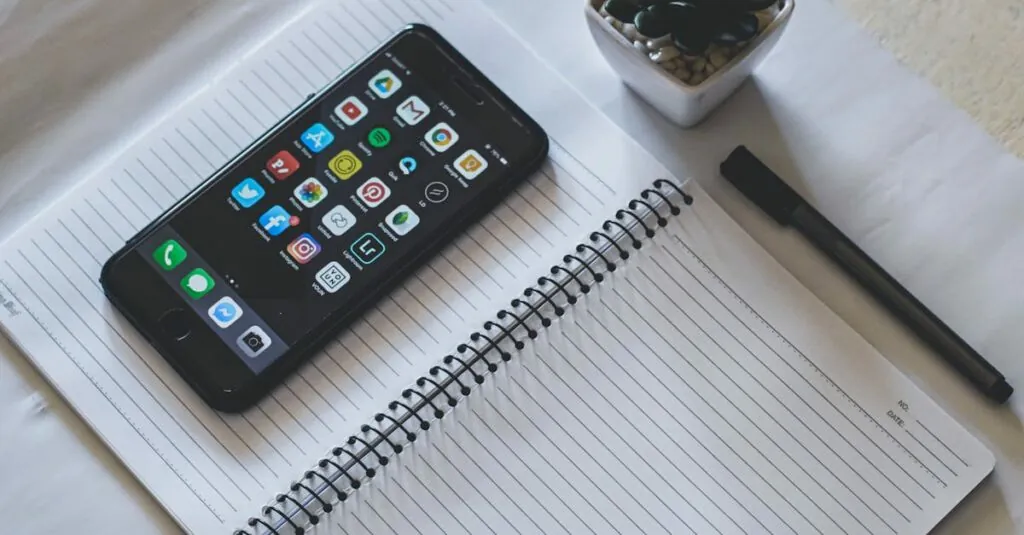Table of Contents
ToggleEver accidentally deleted an app and felt that sinking feeling in your stomach? You’re not alone. Whether it’s that game you swore you’d play again or the productivity tool that promised to revolutionize your life, losing an app can feel like losing a part of your digital soul. But don’t panic just yet!
Understanding Deleted Apps on iPhone
Losing apps from an iPhone can seem daunting, but understanding the process of deletion can ease concerns. Recovery options exist, making it easier to restore favorite apps.
What Happens When You Delete an App?
When a user deletes an app, the action removes the app’s data and content from the device. Apps no longer appear on the home screen, but the deletion does not erase the app from the App Store. Users can easily reinstall apps through the App Store, provided they originally downloaded them. Restoring purchased or downloaded apps is possible, as they remain linked to the user’s Apple ID. App settings and data, however, may not be recoverable unless backed up through iCloud or another method.
Common Misconceptions About Deleted Apps
Many people believe that deleted apps are lost forever. In reality, as long as the app remains available on the App Store, reinstallation remains an option. Some assume that deleting an app clears stored data across all devices. This misconception can lead to confusion about synchronization. Users often think the app will stay deleted if they remove it from one device. Instead, reinstallation on a different device is straightforward, as long as they are signed in with the same Apple ID.
Methods to Find Deleted Apps
Several methods exist to locate deleted applications on an iPhone. Users can utilize the App Store, App Library, and search functions to restore their favorite tools.
Check the App Store
The App Store offers a straightforward way to find deleted apps. Open the App Store and tap on the profile icon in the top right corner. Then, select “Purchased” to view a list of previously downloaded applications. Users can filter this list by checking “Not on this iPhone” to find and easily reinstall apps that were deleted. Reinstalling apps from this list often restores access without data loss.
Use the App Library
The App Library serves as a comprehensive directory for applications on the iPhone. Swipe left from the home screen until the App Library appears. It organizes apps into categories like Social, Entertainment, and Productivity. Users can scroll through or utilize the search bar at the top to locate previously deleted apps. If the app isn’t visible, it can be re-downloaded from the App Store.
Search Your iPhone
Searching the iPhone directly offers a quick method to find deleted apps. Swipe down on the home screen to reveal the search bar. Enter the app’s name into the search field. If the app remains installed, it appears in the results. If it has been deleted, search results may suggest reinstalling it from the App Store. You’ll receive instant access to reinstallation with just a few taps.
Restoring Deleted Apps
Restoring deleted apps on an iPhone is straightforward and user-friendly. Multiple options exist for users to retrieve their favorite applications.
Reinstalling Purchased Apps
Reinstalling apps that were previously purchased is simple. Users can open the App Store, tap on their profile icon, and select “Purchased.” This section lists all apps ever downloaded. Filtering by “Not on this iPhone” shows apps currently absent on the device. Tapping the download button next to the app reinstalls it quickly. Remember, apps purchased through the Apple ID are not lost forever.
Finding Free Apps Again
Finding free apps again is also efficient. Users can return to the App Store and search for the app’s name directly. The search feature suggests variants, making it easy to find what was lost. Browsing through the “Top Charts” or “Categories” may reveal appealing options. App locations are familiar, ensuring users can recap their favorite free tools without challenges. Users typically rediscover what they need in just a few taps.
Tips for Managing Apps on Your iPhone
Managing apps on an iPhone helps enhance user experience. Keeping everything organized allows for easy access and retrieval of important applications.
Organizing Your Home Screen
Start by placing frequently used apps on the first home screen. Prioritize essential tools like messaging, email, and navigation for quick access. Swipe right to access the App Library, an excellent way to view all installed apps at a glance. Sorting applications into categories simplifies navigation, making it easier to locate specific apps when needed. Change app positions by long-pressing an icon and dragging it to the desired location. Utilize widgets for vital information, ensuring key updates are visible without opening apps.
Using Folders for Better Organization
Creating folders offers a streamlined approach to managing apps. Group similar applications, such as games or productivity tools, into dedicated folders for easy access. Long-press an app icon until the menu appears, then select “New Folder” to start organizing. Rename folders according to their content, which aids in identifying them at a glance. Add more apps to existing folders by dragging them over. Regularly review and update folders to keep them relevant, removing apps no longer in use to maintain organization. This method reduces clutter and enhances efficiency throughout the device.
Finding deleted apps on an iPhone is a straightforward process that can alleviate the frustration of losing favorite tools and games. With options like the App Store’s “Purchased” section and the App Library, users can quickly locate and reinstall apps they thought were lost for good.
It’s important to remember that while the app’s data may not be recoverable, the app itself remains accessible as long as it was originally downloaded. By utilizing the search function and organizing apps effectively, users can enhance their experience and keep their devices clutter-free. Embracing these methods ensures that app management becomes a seamless part of daily life.





